Sin City (2005)
DIRECTOR: Robert Rodriguez
CAST:
Bruce Willis, Mickey Rourke, Clive Owen, Jessica Alba, Jaime King, Rosario Dawson, Benicio del Toro, Brittany Murphy, Carla Gugino, Nick Stahl, Michael Clarke Duncan, Elijah Wood, Alexis Bledel, Devon Aoki, Josh Hartnett, Michael Madsen, Rutger Hauer, Powers Boothe, Tommy Flanagan
REVIEW:
Sin City is an adaptation of three stories in a series of ultra-violent, hyper-stylized graphic novels by Frank Miller set in the crime-ridden metropolis of Basin City, dubbed Sin City by its inhabitants. Miller had been approached several times stretching all the way back to the early ’90s, but had steadfastly refused to turn over filming rights until he watched and was astonished by a short film (which became the movie’s opening scene) by director Robert Rodriguez that convinced him of Rodriguez’s determination to be faithful to the source material. In fact, Rodriguez credited Miller as an assistant director, because almost every scene in the film was copied as closely as possible from Miller’s illustrations. Sin City was filmed almost entirely on green screen, and the result is a film that looks and feels like Rodriguez did not really make a movie, but animated a comic book, pumped it full of steroids and testosterone, and captured it in motion. This is pure escapist, gleefully over-the-top entertainment, and as long as you don’t take it too seriously, and have no qualms about onscreen violence, it’s a blast of wildly original, hyperkinetic fun from start to finish, with only a few drags along the way. In some ways it’s a deliberate nod to ‘50s noir- the black-and-white, the trench coats billowing in the wind, women are called dames, and a bad heart is called a bum ticker- but in others- the casual nudity and the cartoonishly extreme violence- it’s thoroughly modern. It’s definitely not for the prudish or the squeamish, it’s definitely strictly for adults, and it definitely won’t be everyone’s cup of tea, but Sin City is nothing if not original and visually arresting.
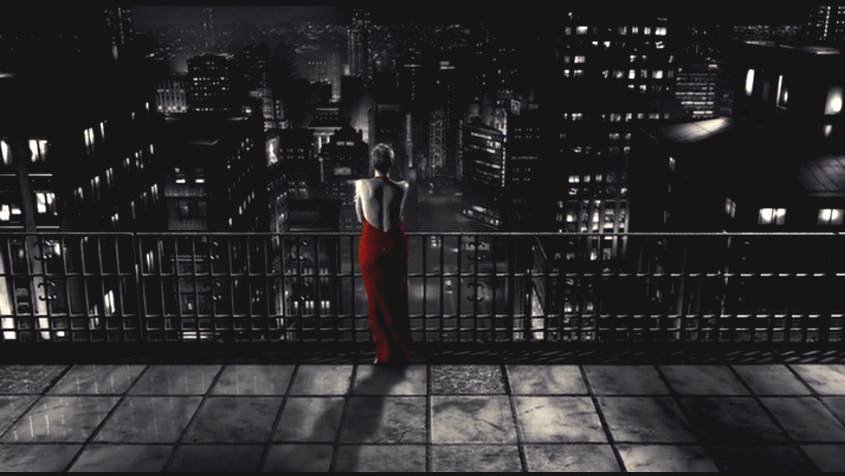
Sin City exists in a skewed dimension all its own, with ’50s slang and cars from every decade thrown together in a murky netherworld where it always seems to be the middle of the night, where people turn into mutated yellow freaks with vague explanations at best, people get hit with cars, tossed into the air like rag dolls, and then brush themselves off and get going, and gunshots send people flying clear across the room. This is also pretty likely to be the only movie you’re going to see with a fight scene between, of all the possible two people, Mickey Rourke and Elijah Wood. If you question any of the above, you’re not going in with the right attitude.
The three Miller storylines used in the film are That Yellow Bastard, The Hard Goodbye, and The Big Fat Kill. The film is split between these three plotlines, not necessarily in chronological order, and while a few supporting characters pop up in more than one, for the most part they are three self-contained slices of life in Sin City.
That Yellow Bastard
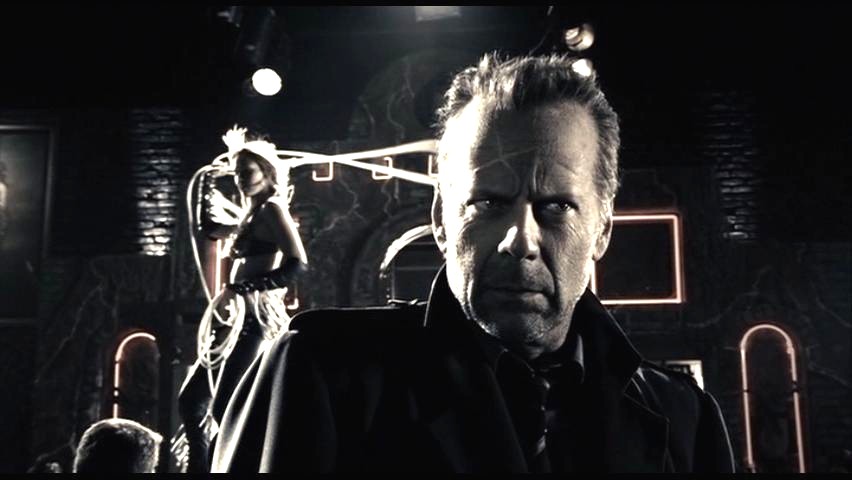 In this sleazy town, Lt. John Hartigan (Bruce Willis) seems entirely too honorable for his own health. An honest cop driven into early retirement by a ‘bum ticker’, he dutifully spends his last hour on the force rescuing a young girl named Nancy Callahan (Makenzie Vega) from a pedophile called Junior (slimily played by Nick Stahl). In a better world, he’d be celebrated as a hero. In Sin City his reward is being shot multiple times in the back by his crooked partner (Michael Madsen), convicted of being a child rapist himself, and spending eight years in the slammer- thanks to the influence of Junior’s all-powerful father, Senator Roark (Powers Boothe), who wants him to live ‘destroyed, disgraced, alone’. Hartigan is kept going through the years by an endless stream of letters from Nancy, who he is surprised to find is now an erotic dancer (Jessica Alba), whose devotion to him goes beyond platonic, only to have his war with Junior pick up where it left off, with the sexual predator having transformed into the grotesque Yellow Bastard, who is intent on wreaking a terrible revenge on Hartigan and finishing what he started with Nancy.
In this sleazy town, Lt. John Hartigan (Bruce Willis) seems entirely too honorable for his own health. An honest cop driven into early retirement by a ‘bum ticker’, he dutifully spends his last hour on the force rescuing a young girl named Nancy Callahan (Makenzie Vega) from a pedophile called Junior (slimily played by Nick Stahl). In a better world, he’d be celebrated as a hero. In Sin City his reward is being shot multiple times in the back by his crooked partner (Michael Madsen), convicted of being a child rapist himself, and spending eight years in the slammer- thanks to the influence of Junior’s all-powerful father, Senator Roark (Powers Boothe), who wants him to live ‘destroyed, disgraced, alone’. Hartigan is kept going through the years by an endless stream of letters from Nancy, who he is surprised to find is now an erotic dancer (Jessica Alba), whose devotion to him goes beyond platonic, only to have his war with Junior pick up where it left off, with the sexual predator having transformed into the grotesque Yellow Bastard, who is intent on wreaking a terrible revenge on Hartigan and finishing what he started with Nancy.
The Hard Goodbye
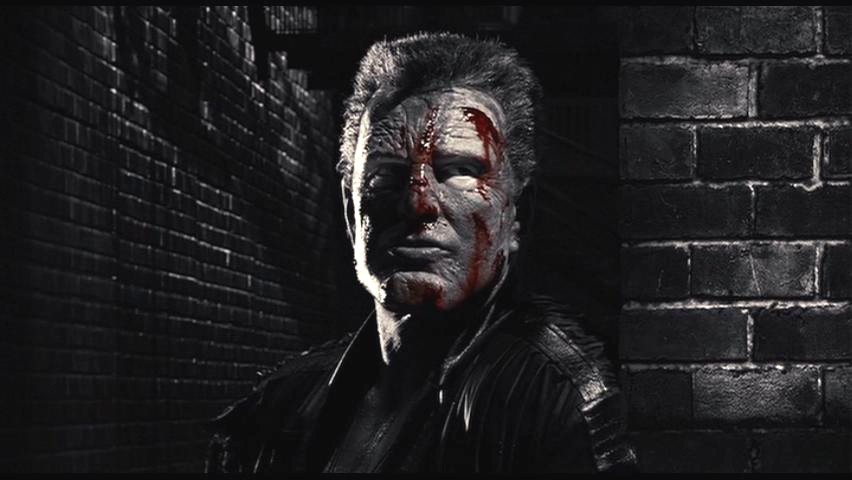 Marv (Mickey Rourke) has never had much luck with the ladies. Treating women right is his main honor point, but he’s otherwise a violence-prone thug with a volatile ‘condition’ and a face like a boulder. Then one night, he somehow hooks up with a blond bombshell called Goldie (Jaime King) and spends one blissful night with the woman of his dreams, only to wake up to find her laying dead next to him and the police storming the building to arrest him for her murder. But the forces who’ve framed him have made one fatal mistake. Don’t mess with Marv. After proving too much for a building full of cops to handle, Marv sets out to find Goldie’s killer and give him ‘the hard goodbye’. Marv tears through Sin City like an avenging force of destruction, working his way to the truth one kill at a time, until the trail leads to a lethal cannibal (Elijah Wood as the anti-Frodo) and maybe even all the way up to the powerful Cardinal Roark (Rutger Hauer). And he’s being followed around by a woman who looks an awful lot like Goldie but is significantly less friendly.
Marv (Mickey Rourke) has never had much luck with the ladies. Treating women right is his main honor point, but he’s otherwise a violence-prone thug with a volatile ‘condition’ and a face like a boulder. Then one night, he somehow hooks up with a blond bombshell called Goldie (Jaime King) and spends one blissful night with the woman of his dreams, only to wake up to find her laying dead next to him and the police storming the building to arrest him for her murder. But the forces who’ve framed him have made one fatal mistake. Don’t mess with Marv. After proving too much for a building full of cops to handle, Marv sets out to find Goldie’s killer and give him ‘the hard goodbye’. Marv tears through Sin City like an avenging force of destruction, working his way to the truth one kill at a time, until the trail leads to a lethal cannibal (Elijah Wood as the anti-Frodo) and maybe even all the way up to the powerful Cardinal Roark (Rutger Hauer). And he’s being followed around by a woman who looks an awful lot like Goldie but is significantly less friendly.
The Big Fat Kill
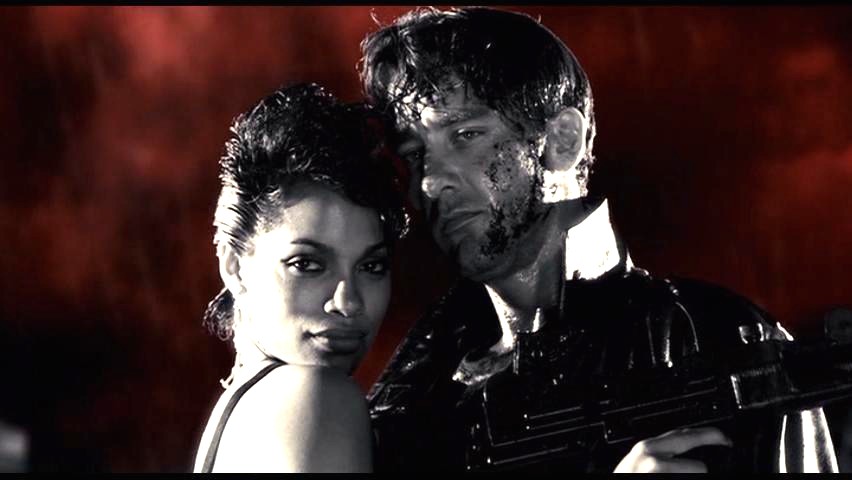 Elsewhere in the city, Dwight McCarthy (Clive Owen), a man with a shady past and a new face who shares Marv’s protective feelings toward women, gets dragged into a conflict between an alcoholic thug, Jacky Boy (Benicio del Toro), and the women of Old Town, gun-toting prostitutes who have an arrangement with the police and the mob that lets them run things on their own turf. But when Jacky Boy ends up dead- and worse, turns out to be a decorated cop- it’s up to Dwight and his on-again off-again love Gail (Rosario Dawson), ruler of Old Town, to prevent the shattering of the truce and the invasion of Old Town led by a hulking enforcer (Michael Clarke Duncan).
Elsewhere in the city, Dwight McCarthy (Clive Owen), a man with a shady past and a new face who shares Marv’s protective feelings toward women, gets dragged into a conflict between an alcoholic thug, Jacky Boy (Benicio del Toro), and the women of Old Town, gun-toting prostitutes who have an arrangement with the police and the mob that lets them run things on their own turf. But when Jacky Boy ends up dead- and worse, turns out to be a decorated cop- it’s up to Dwight and his on-again off-again love Gail (Rosario Dawson), ruler of Old Town, to prevent the shattering of the truce and the invasion of Old Town led by a hulking enforcer (Michael Clarke Duncan).
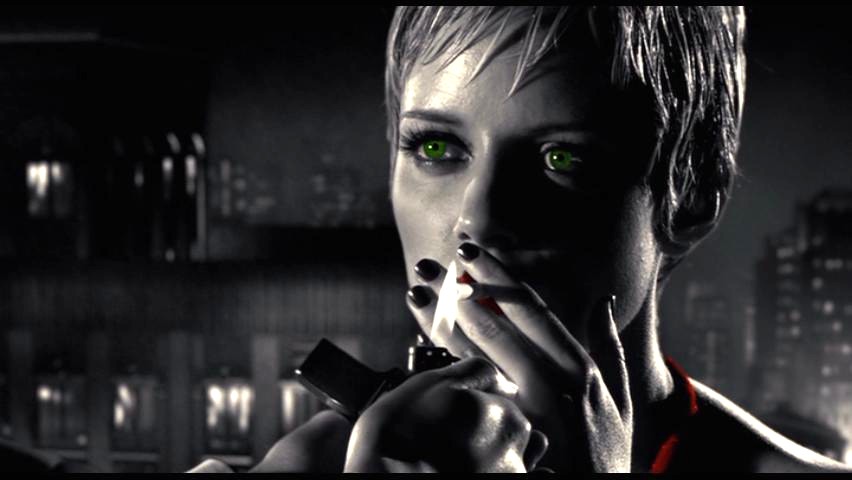 Structurally, aside from a cameo bookending the film featuring Josh Hartnett as an enigmatic hitman, we start with the prologue to That Yellow Bastard and then move on through The Hard Goodbye and The Big Fat Kill before finishing up with Hartigan’s story. Sin City peaks early with The Hard Goodbye, the most fast-paced, wildly entertaining, and gleefully sadistic story the movie has to offer. Things slow down with The Big Fat Kill; there’s plenty of gallows humor, especially a scene by guest director Quentin Tarantino involving Dwight’s imagined conversation with the nearly-decapitated corpse of Jacky Boy, but the plot’s not as tight or compelling, and meanders around a little. We build up more momentum with the conclusion of That Yellow Bastard, with Hartigan’s final confrontation with Junior packing an echo of the thrill of Marv’s ferocious revenge on the killers of Goldie, but That Yellow Bastard is also the story that plays the closest to straight, and thus isn’t as much fun.
Structurally, aside from a cameo bookending the film featuring Josh Hartnett as an enigmatic hitman, we start with the prologue to That Yellow Bastard and then move on through The Hard Goodbye and The Big Fat Kill before finishing up with Hartigan’s story. Sin City peaks early with The Hard Goodbye, the most fast-paced, wildly entertaining, and gleefully sadistic story the movie has to offer. Things slow down with The Big Fat Kill; there’s plenty of gallows humor, especially a scene by guest director Quentin Tarantino involving Dwight’s imagined conversation with the nearly-decapitated corpse of Jacky Boy, but the plot’s not as tight or compelling, and meanders around a little. We build up more momentum with the conclusion of That Yellow Bastard, with Hartigan’s final confrontation with Junior packing an echo of the thrill of Marv’s ferocious revenge on the killers of Goldie, but That Yellow Bastard is also the story that plays the closest to straight, and thus isn’t as much fun.
The large cast has style, look, and attitude required from them more than acting jobs, but on the whole, Rodriguez’s casting sense is something close to ingenious, filling out the noir anti-heroes with names and faces like Mickey Rourke, Bruce Willis, and Clive Owen who embody the perfect screen archetypes to fill them out. These choices fit like hands in gloves, but Rodriguez also thinks creatively outside of the box in some other parts: to how many other minds, for example, would it have ever occurred to cast Elijah Wood as a character who’s best summed up as a kind of cannibalistic serial killer ninja? The juiciest part goes to Mickey Rourke, almost unrecognizable under prosthetic makeup, who has easily his best role in years as Marv, who has a soft spot for women and adheres so strongly to his own brand of rough justice that he’s determined to brutally massacre everyone even remotely connected to her death or die trying. Rourke is letter-perfect for the part, and his bloodthirsty gusto makes him delicious fun to follow around as he tears through the town exacting bloody vengeance. His gravelly voice works perfectly for the narration, and practically every line that comes out of his mouth is wonderfully quotable. ‘I love hitmen. No matter what you do to them, you don’t feel bad’. Clive Owen, despite a pretty dodgy stab at an American accent, is equally cool (though not as imposing) and supplies plenty of deadpan humor. Dwight has a little in common with Marv- both hard-edged criminals with chivalrous notions about women- but while Dwight doesn’t shy away from violence, he doesn’t embrace it with Marv’s bloodthirsty relish. In the midst of all the campiness and scenery-chewing, Bruce Willis is the more-or-less straight man, world-weary, dedicated Hartigan. In a city filled with sick and twisted villains and edgy anti-heroes, Hartigan is easily the closest to a hero to be found, and his unwavering devotion to Nancy ends his story on a surprisingly poignant note.
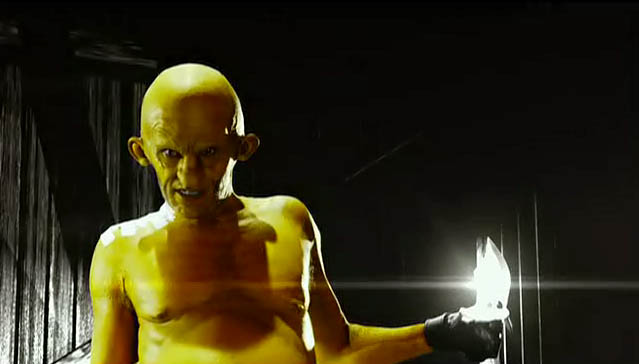 Of the supporting cast, Michael Madsen is wooden and seems thoroughly bored as Hartigan’s partner Bob but isn’t in it enough to be a major distraction, Brittany Murphy overdoes her saucy dame shtick, and Jessica Alba’s shapely figure will distract most male teenage viewers from her acting limitations. Michael Clarke Duncan’s hulking, verbose Manute is the least memorable of the bad guys; despite his imposing frame, he’s pretty boring. On the other hand, Benicio del Toro is clearly enjoying himself immensely as Jacky Boy, chomping on the scenery like he’s having the time of his life. Also doing some teeth-gnashing is Nick Stahl, who spends all but a couple minutes of his screentime under unrecognizable makeup as the hideous Yellow Bastard, oozing across the screen with such pure vile sleaze that you almost expect to see a slime trail stretching out behind him. Flashy female supporting turns come from Jaime King in a dual role, Rosario Dawson as the tough-as-nails warrior woman Gail, and Carla Gugino, who spends most of her screentime almost completely naked, as Marv’s lesbian parole officer Lucille, of whom he says ‘she’s a dyke, but God knows why. With that body of hers she could have any man she wants’. On down the cast list, almost every cast member seems to be having fun, and almost everyone gets at least a little juicy moment or two. A couple of the smaller roles are among the most striking. The aforementioned Elijah Wood shows up about as far removed from Frodo Baggins as imaginable as Kevin, a silent killer who doesn’t speak a word but fights like a weightless whirling dervish and has the nasty habit of eating women and mounting their heads on his wall like hunting trophies. He doesn’t have much screentime, but makes an impression. In fact, Wood is so spooky that this is likely to be at least one movie where his presence does not remind viewers of Frodo. Devon Aoki is Old Town’s fiercest defender, ‘deadly little Miho’, who like Kevin doesn’t say a word but has a nasty way with a sword and assorted other weapons and is someone you’d love to have on your side and hate to have against you. There are cameos from a bald Rutger Hauer as the depraved Cardinal Roark who shares a sinister secret with Kevin, and Powers Boothe, who gets a juicy little speech about what really holds Sin City together. Also on hand are Alexis Bledel as one of the women of Old Town, Tommy Flanagan as an Irish mercenary, and Sin City creator Frank Miller himself as a crooked clergyman who’s confronted by Marv and makes the very bad mistake of insulting Goldie.
Of the supporting cast, Michael Madsen is wooden and seems thoroughly bored as Hartigan’s partner Bob but isn’t in it enough to be a major distraction, Brittany Murphy overdoes her saucy dame shtick, and Jessica Alba’s shapely figure will distract most male teenage viewers from her acting limitations. Michael Clarke Duncan’s hulking, verbose Manute is the least memorable of the bad guys; despite his imposing frame, he’s pretty boring. On the other hand, Benicio del Toro is clearly enjoying himself immensely as Jacky Boy, chomping on the scenery like he’s having the time of his life. Also doing some teeth-gnashing is Nick Stahl, who spends all but a couple minutes of his screentime under unrecognizable makeup as the hideous Yellow Bastard, oozing across the screen with such pure vile sleaze that you almost expect to see a slime trail stretching out behind him. Flashy female supporting turns come from Jaime King in a dual role, Rosario Dawson as the tough-as-nails warrior woman Gail, and Carla Gugino, who spends most of her screentime almost completely naked, as Marv’s lesbian parole officer Lucille, of whom he says ‘she’s a dyke, but God knows why. With that body of hers she could have any man she wants’. On down the cast list, almost every cast member seems to be having fun, and almost everyone gets at least a little juicy moment or two. A couple of the smaller roles are among the most striking. The aforementioned Elijah Wood shows up about as far removed from Frodo Baggins as imaginable as Kevin, a silent killer who doesn’t speak a word but fights like a weightless whirling dervish and has the nasty habit of eating women and mounting their heads on his wall like hunting trophies. He doesn’t have much screentime, but makes an impression. In fact, Wood is so spooky that this is likely to be at least one movie where his presence does not remind viewers of Frodo. Devon Aoki is Old Town’s fiercest defender, ‘deadly little Miho’, who like Kevin doesn’t say a word but has a nasty way with a sword and assorted other weapons and is someone you’d love to have on your side and hate to have against you. There are cameos from a bald Rutger Hauer as the depraved Cardinal Roark who shares a sinister secret with Kevin, and Powers Boothe, who gets a juicy little speech about what really holds Sin City together. Also on hand are Alexis Bledel as one of the women of Old Town, Tommy Flanagan as an Irish mercenary, and Sin City creator Frank Miller himself as a crooked clergyman who’s confronted by Marv and makes the very bad mistake of insulting Goldie.
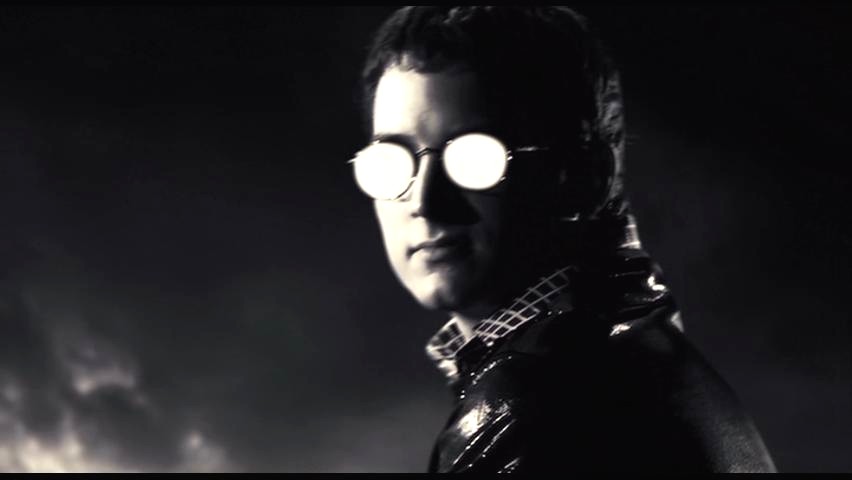 Much has been made of the graphic violence, perhaps too much. This is certainly not a movie for those who have a problem with violence, but it’s so hyper-stylized and cartoonishly over-the-top that it doesn‘t have the disturbing effect it might have if it was meant to be taken more seriously. Although her character is an erotic dancer, Jessica Alba refused to do nudity (Carla Gugino has no such inhibitions). When color appears, it has a point and an effect. Goldie, the one bright spot in Marv’s life, is colorized in contrast to the black-and-white world around her. When Josh Hartnett’s character compliments a woman on her eyes, they briefly flare into color. As his name suggests, the Yellow Bastard is yellow, which in this movie certainly makes him stand out. Alexis Bledel’s eyes are in color, as are Rutger Hauer’s, which gives his creepy priest a spooky effect. There are other flashes of color- a woman’s red dress, the bar where Nancy dances, a few splatters of blood. Even for viewers who aren’t engaged by the stories, eye candy doesn’t go halfway toward explaining how much Sin City drips with style from every corner of the screen. As yet another example of the supreme bad judgment prevalent among many Hollywood studio executives, some of those behind Sin City were pushing for it to stick to a PG-13 rating. Every fan of this film and of the graphic novels it’s based on with such strict fidelity must applaud Robert Rodriguez for sticking to his guns. A PG-13 Sin City would have been a neutered shadow of itself.
Much has been made of the graphic violence, perhaps too much. This is certainly not a movie for those who have a problem with violence, but it’s so hyper-stylized and cartoonishly over-the-top that it doesn‘t have the disturbing effect it might have if it was meant to be taken more seriously. Although her character is an erotic dancer, Jessica Alba refused to do nudity (Carla Gugino has no such inhibitions). When color appears, it has a point and an effect. Goldie, the one bright spot in Marv’s life, is colorized in contrast to the black-and-white world around her. When Josh Hartnett’s character compliments a woman on her eyes, they briefly flare into color. As his name suggests, the Yellow Bastard is yellow, which in this movie certainly makes him stand out. Alexis Bledel’s eyes are in color, as are Rutger Hauer’s, which gives his creepy priest a spooky effect. There are other flashes of color- a woman’s red dress, the bar where Nancy dances, a few splatters of blood. Even for viewers who aren’t engaged by the stories, eye candy doesn’t go halfway toward explaining how much Sin City drips with style from every corner of the screen. As yet another example of the supreme bad judgment prevalent among many Hollywood studio executives, some of those behind Sin City were pushing for it to stick to a PG-13 rating. Every fan of this film and of the graphic novels it’s based on with such strict fidelity must applaud Robert Rodriguez for sticking to his guns. A PG-13 Sin City would have been a neutered shadow of itself.
Sin City might not be a great movie in the traditional sense, but it’s easily one of the most visually inventive and original films in recent memory, and those who crave giddily over-the-top ultra-violence served up with tremendous style and panache and black comedy, and populated by a rogue’s gallery of colorful heroes, villains, anti-heroes, and damsels in and out of distress, should find the movie an endless delight.
***1/2